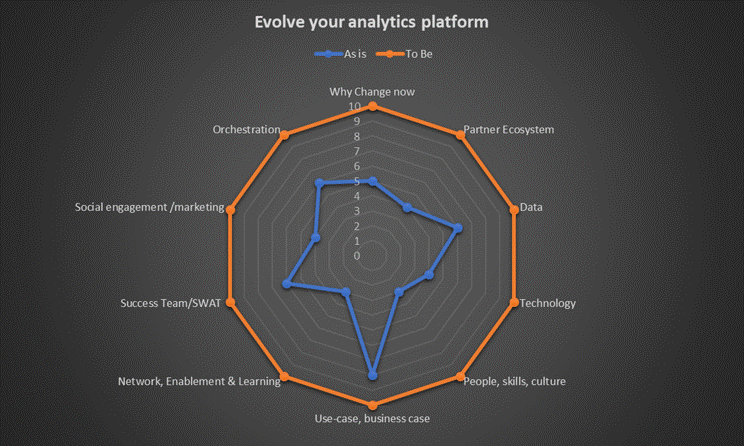Digital transformation and analytics/AI are at the top of the agenda. But wait – is there anything new about it? Innovation? No. Transformation? No. Value-driven approaches? No. Is it even worth talking about AI? YES, it is!
The competitive landscape and the speed of inventing new products, services and new features have dramatically increased. It is worth asking yourself if you have an appropriate analytics strategy. Are you successfully running a digital transformation program? If yes, then you're on the bright side of life. If not, you probably need support. See what you can take from my top advice to address your goals.
The figure above illustrates how you can evaluate your program/project analytical readiness. Start with a whiteboard exercise. Here you mark the transformation drivers. What is it that you want to change?
Probably it’s the way you interact with your customers. Why do you need to improve it (or slow them down?). Assuming you want to strengthen your market share, you should, of course, strengthen your relationship with your customers. You may need deeper customer insights into what they request from you and how they will act in the near future.
And here analytics enters the arena. For example, you can use analytics to find out which customer will be your customer the day after tomorrow. You can find out with analytics how you best approach your customer by being aware of his fields of interest and where he stays currently. You see, you can also answer how, when, where and what to approach the customer with by designing the customer journey using analytics.

Speedboating
But now, I guess, you feel uncomfortable. You may have no clue how to achieve this goal! Sometimes partners help. Choose the ones who are familiar with analytics and can explain how to apply it in your industry. You don’t need to innovate everything yourself. Take advantage and learn from your partner ecosystem – it’s much faster and easier on your way to success. Your partners could be your "speedboat” for learning and growth.
My advice at this point would be to choose partners who do not only have the current moment in mind. It is best to choose a partner who supports your long-term strategies. After all, analytics is a broad field that could put completely different demands on your business tomorrow than it does today. And, together with your trusted partner, you can then turn to your focal point: your data. Most likely, your company has a lot of data – otherwise, you wouldn't care about analytics. So I suppose that data is your energy source. If that's not the case so far, now comes the turning point in your thinking. My second piece of advice: Consider your data as the energy source for your business.
Data in symbiosis
Do you have access to the right data? Try to answer this question with your trusted partner. Where is it? And here is the playground for your partner to find out if your data is ready for analytics. My third piece of advice: You should always address data in symbiosis with what business issue you want to solve. Not as an isolated data task.
We have arrived at the core of AI/analytics, in particular, the technology behind it. As you may imagine, technology plays a major role in transforming your enterprise from analogue to digital. There are many different options from open source and commercial software, different cloud vendors and security considerations. Step into several perspectives before you decide on a certain technology. You will need to consider openness, scalability, flexibility, performance, security, cost, manageability and governance. Finally, don’t forget speed, from model development to deploying your analytics in production.
It's still all about people
Even though technology and data play a key role, it’s still all about people. Make sure you understand the maturity of your organisation and the skill gaps that you need to fill. Work smart, align your analytics initiative with your company strategy, get management to buy in, start small but think big and show success. Communicate, educate the whole company on different levels, use external knowledge to inspire and help you drive change. Find a group of change agents to drive and evolve your business. And ask yourself and management, does our culture allow us to fail and try again? How do you get your organisation to connect and work together? I believe with a solid business use case it’s always easier to drive change. If you, in addition, can connect the use case with your company goals and growth initiative, you will definitely have an easier path to success.
My advice at this point would be to choose partners who do not only have the current moment in mind. Click To TweetAs you may imagine, people are hungry, not only for food reasons but also for intellectual ones due to the current hype around AI. This leads us to learning and enablement. I would advise you to create networks, mixing competencies to learn from each other. Also, face the ethical part of AI in your discussions and try to apply it to your analytics. Have you ever taken a “SWAT team” into consideration? If not, please do! However, it’s hard to lead people without orchestration. My final bit of advice is to make sure you have proper orchestration to evolve your digital/analytics platform, which, of course, depends on the scope of your ambitions.
Here are my key roles to consider:
- Business value team lead – calculating the business value and visualising the why now perspective.
- Social marketing and communication lead – driving internal awareness and engaging spearheads in internal marketing/visibility activities.
- Analytical life cycle lead – securing the data, model development, testing, deployment and monitoring to secure that it all fits together.
- Data engineer – securing that you have access to the right data.
- Data scientist – make business recommendations with complex machine learning models, and then deploy models at scale.
- Technology/architecture lead – Utilising technology, partner ecosystem and cloud vendors to drive value and speed.
- Business analyst – asking the right questions, reviewing and analyzing the results.
- Enablement lead – identifying enablement needs and skills gaps to fill and create enablement road maps.
- Ethics lead – considering ethical AI guidelines for your organisation.

